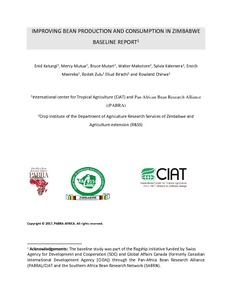Improving bean production and consumption in Zimbabwe baseline report
This report presents descriptive information from a baseline study conducted in 2016 to benchmark the indicators of outcomes of the flagship initiative in Zimbabwe, understand the drivers of bean improved technology adoption and potential impacts of the initiative. The primary data from 752 bean growing households that were selected from 15 districts with highest bean area were used. These districts were selected from a list of 60 districts because they allocate the largest area to bean production in 2013-2015. Study findings revealed increased severity of bean production constraints that significantly reduce bean productivity, thus PABRA focus on Zimbabwe as a flagship country for improving bean production and productivity will help poorer households access more bean for consumption. So far, households demonstrate limited awareness of improved technologies including varieties, which calls for enhanced dissemination in terms of geographical scope and capacity of farmers on how to implement it profitably. Interventions should also account for the risk of rainfall failure by putting emphasis on climate smart technologies. Irrigation is one of climate smart technologies that have been promoted in Zimbabwe and is helping farmers make huge profits from bean production. These farms have a potential to produce more surplus for marketing after expanding their area under beans. Simulations under various scenarios revealed that for the new technology to be attractive to farmers, they should generate at least yield increase of 30%. Technologies will be attractive even with 10% yield increase if adoption is accompanied by irrigation. However, use of irrigation is associated with increased demand for hired and family labour, with women likely to bear more burden of extra unpaid labour. All interventions need to be sensitive to gender as women and men contribute unpaid labour and participate in decision making for bean production and marketing but with varying intensities in specific activities or decisions.

